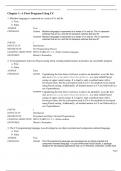Tentamen (uitwerkingen)
Test Bank for Microsoft Visual C#: An Introduction to Object-Oriented Programming, 8th Edition by Joyce Farrell
- Vak
- Instelling
Test Bank for Microsoft Visual C#: An Introduction to Object-Oriented Programming, 8e 8th Edition by Joyce Farrell. Complete Chapters test bank are included with answers. Chapter 1. A First Program Using C# Chapter 2. Using Data Chapter 3. Using GUI Objects and the Visual Studio IDE Chapter 4...
[Meer zien]



